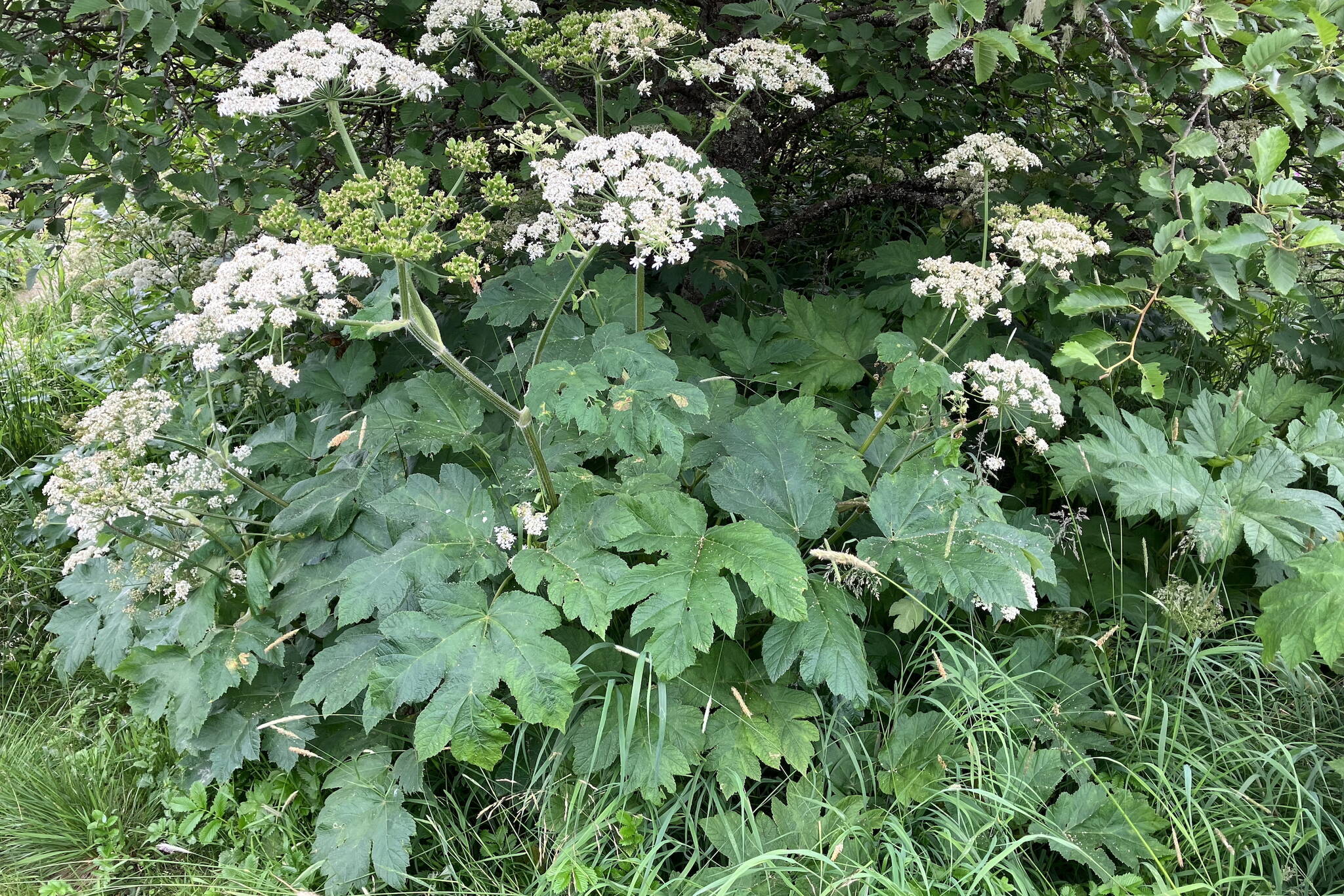Out on the wetlands at the end of Industrial Boulevard in early July, Lincoln’s sparrows and savannah sparrows were everywhere, chipping and flitting. Shorebirds were foraging in the sloughs at low tide — a greater yellowlegs and four small ones that quickly vanished.
Irises had apparently been well-pollinated, presumably by bees, and were producing many fat seed-pods. But lupines, which are also bee-pollinated, had not done so well; many parts of the now-faded inflorescences bore no seed pods at all. The colorful array of flowers was largely past, except for beach pea and silverweed. So the flower show featured lots of white flowers—yarrow, beach lovage, and cow parsnip.
Cow parsnip (a.k.a. pushki or so-called Indian rhubarb) also adorns many of our roadsides and trails and it pops up in gardens. Trail walkers and gardeners often brush past or break the tall, leafy stems. The uninitiated may not know and so they sometimes learn to their discomfort that the juices of this plant are phototoxic. The fluids from broken leaves and stems contain chemicals that are activated by exposure to sunlight (UV in particular), causing rashes and sometimes huge blisters; scar tissue from those injuries can be permanent in some cases. The dermatitis reaction is not immediate, but generally takes some hours to develop. Simply brushing lightly past intact leaves is unlikely to cause such problems. But if the sap gets on your hands and clothing, it can be transferred to bare skin or eyes, sometimes leading to major damage and blindness, or breathed as vapor, causing respiratory problems. Likewise, if a dog prances about in a stand of cow parsnip, it could get the sap on its poorly furred parts, causing a rash, and on its fur, from which it could be transferred to a human.
Parts of this plant are said to be edible, especially when they are very young. But that may be a risky business. Peeling the stalk significantly reduces the amount of phototoxins, but eating large quantities of peeled stalk can be dangerous. Apparently the ingested phototoxic chemicals can be circulated by the bloodstream and cause the unwanted dermatitis when exposed to UV light. However, the roots and dried seeds are reported to be less risky.
The introduced Eurasian plant that gardeners know as parsnip (which is sometimes, confusingly, also called cow parsnip when it becomes an invasive weed) belongs to a different genus, but shares the phototoxic properties of our local cow parsnip. Both of these species and many of their close relatives (such as celery) in the same taxonomic family (carrot family or Apiaceae, formerly Umbelliferae) contain furanocoumarins, a group of related chemicals with powerful biological actions. The production of furanocoumarins, including the identity and proportions of the particular types, is genetically controlled, but production can vary with growing conditions (amount of light, nutrients) and can also be induced by herbivore activity. Therefore the amount of furanocoumarin can vary widely among populations and cultivars. The toxins are apparently found in all parts of these plants and are not de-activated by cooking, so too much handling or too much eating of them could produce unpleasant symptoms when skin is exposed to sunlight. Many other plants contain phototoxic chemicals, including members of the citrus family, as well as some fungi and bacteria.
Furanocoumarins may absorb excess UV light that could damage the plant. But they are also part of the plant’s defense against insect herbivores, fungi, bacteria, and grazing mammals. They work by inducing cross-linkages of DNA strands and disrupting cellular DNA function, by denaturing proteins, and generating free-radicals. Insects that are generalized herbivores are very susceptible to furanocoumarin toxins, although they may avoid extreme exposure by choosing particular hosts or using certain feeding sites that are sheltered from light (such as under leaves or in rolled leaves) or plant parts that contain lower levels of toxins. Specialists have evolved additional ways of coping, typically by detoxifying and metabolizing the furanocoumarins (e.g., some swallowtail butterfly caterpillars, parsnip webworms). A study in eastern U.S. showed that “umbellifers” growing in open, high-light areas were better endowed with furanocoumarins than those that grew in the woods and they had a correspondingly different set of insect herbivores, with specialists predominating in the open area and generalists in the woods. In other systems in which insect herbivores consume toxic plants (such as milkweeds and milkweed herbivores), specialists sequester the toxins for their own defense against predators, but umbellifer feeders do not, presumably because exposure to light would initiate negative reactions. Parsnip webworms, however, reportedly do somehow incorporate plant toxins in their web silk, which may deter parasites and some predators.
Cultivated parsnips and parsnip webworms are species that have been introduced from Eurasia to many parts of the world. Webworm adults are inconspicuous little moths. The larvae build silken webs around the inflorescences and feed on the flowers and seeds; they commonly pupate in burrows in the stem;. Parsnip plants arrived in North America with the early settlers over two hundred years ago, and these cultivars had a relatively low level of furanocoumarins, as shown by museum studies of parsnip plants from the time of early settlement. The webworm arrived here more recently and since then, parsnips in the U.S. have evolved much higher levels of furanocoumarins to counter the feeding activity of the webworm. Parsnips in New Zealand have fewer protective furanocoumarins than parsnips elsewhere, perhaps because they have been free of enemies such as webworms for over a hundred years and ceased to invest so much in chemical defense. Relatively recently, however, the webworm arrived in New Zealand and began to devastate the parsnip populations. It seems likely that the New Zealand parsnips will begin to evolve better chemical defenses in response to the rather new enemy and we may see evolution in action there.

